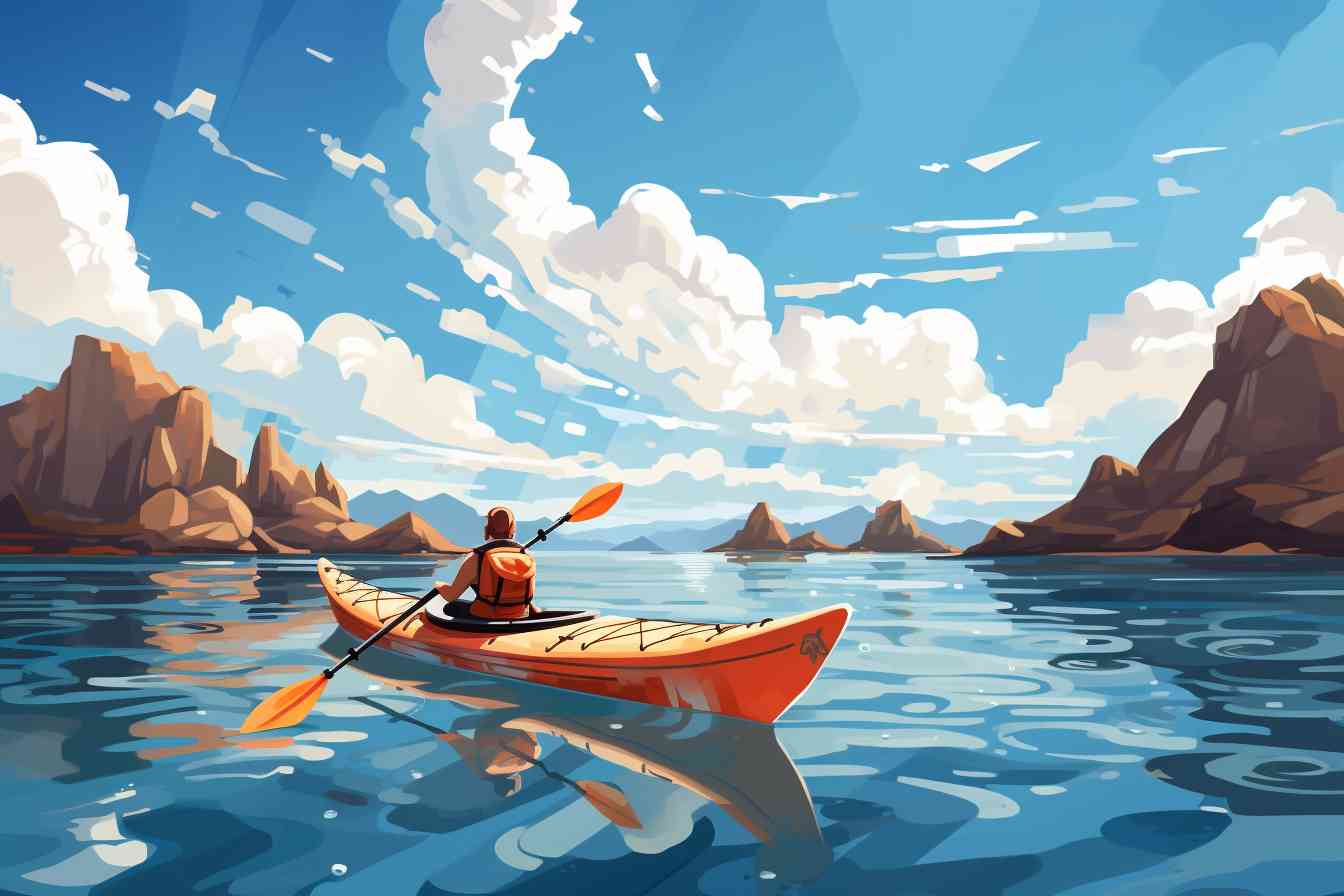Intro: Beginners Guide To Sea Kayaking

Alright then, let’s dive right into the world of sea kayaking, shall we? Now, I reckon you’re a beginner, just dipping your toes in these exciting waters. No worries – we’ve got your back! Sea kayaking – just the sound of it makes you feel like an explorer!. You can imagine yourself, seawater lapping against the sides of your kayak, the rhythmic splash of the paddle against the surf… Trust me, once you’ve experienced it, you’re gonna be hooked for life!
Now, I’m sure you’re asking, ‘where do I start?’ Well, first things first, acquiring the perfect sea kayak! Recommending any one model would just be plain wrong, because remember, each person is unique in their needs and capabilities. So, my advice to you, take your time and research what suits you – kayak length, storage capacity, the material of the kayak, the weight you can manage…everything should be considered! Don’t forget to test them out before buying, either – it’s the best way to get a feel for what you’re going to be using!
Next up, you don’t just hit the sea without training, mate! Paddling, navigation skills, and safety protocols are all essential. Register for a beginner’s course, learn the basics, and then keep practicing. You need to be confident with controlling the kayak, understand how to paddle efficiently and, of course, need to know how to recover if you capsize. Sounds scary, right? It’s okay – everyone flipping over in their kayak for the first time is like a rite of passage. The important thing is to keep calm and remember your training!
Lastly, always, always remember safety first. Sea kayaking is nothing if not unpredictable. Weather changes can be fast and dramatic. So, check the forecast before heading out, ensure you have all essential safety gear – life vest, helmet, whistle, flare, and make sure someone on land knows your route and expected return time.
I can tell you’re ready to embark on this new adventure. Don’t fret about the challenges ahead; they’re part of the ride!. So, get out there, start paddling, and explore those beautiful seascapes. The magic of sea kayaking awaits you!
Can A Beginner Use A Sea Kayak?

I get it – people often ask ‘Can a beginner really handle a sea kayak?’ and I’ve got to tell ya, the curiosity is nothing but genuine! Yes, the answer lies in the affirmative, beginners absolutely can use a sea kayak. But hold on, there are a few important things worth considering.
Sea kayaks, mind you, are a bit different from their recreational counterparts. They’re typically longer and intended to navigate larger bodies of water… and trust me, this adds a whopping layer of complexity. But hey, don’t let that scare you! With proper training and guidance, even a neophyte can master this amazing water sport.
Remember, before you head out into the deep blue, it’s vital to learn the ropes first. Getting some quality instruction, as I always recommend, is the first step – and don’t you dare skimp on this. Safety, paddling techniques, and ‘how to roll’… you gotta get these basics locked down tight.
In the nutshell, don’t be intrepid about using a sea kayak as a beginner. Seeing an ocean sunset from the water, while your hands are busy guiding a sea kayak… it’s just incredible… and trust me on this. But like anything else in life, it requires a responsible, educated approach. So, I say, throw caution to the wind, but make sure it’s an educated caution!
How Do You Start Kayaking In The Ocean?

Alright, so you’re interested in sea kayaking, huh? It really is an exceptional experience! As the salt air fills your lungs and the endless expanse of the ocean envelops you, there’s nothing quite like it. But I must tell ya, it’s not as simple as just hopping into a kayak and paddling out to sea. There are certain steps one must follow to ensure a safe and enjoyable adventure.
Firstly, the best thing you can do is get yourself a kayak designed specifically for the ocean. Regular ones won’t cut it, believe me! They’re built to handle the choppier waves and cab prove to be more stable. Plus, remember to always have a life jacket on. Safety first, folks!
Additionally, you must familiarise yourself with various strokes and maneuvering techniques for the ocean’s unpredictable nature. Practice is the name of the game. It ain’t quite like rowing a boat in a calm pond, the open sea requires a certain level of strength and agility.
Above all else, check the weather forecast! You don’t want to be caught in the middle of a storm or rough seas. Even seasoned kayakers avoid that.
And finally, never go alone if you’re a beginner. Always make sure there’s someone with you who’s experienced or at least, inform someone about your plans. It’s always better to have someone know where you are.
You see, sea kayaking can be thrilling, but it’s just as much about preparation and precaution as it is about the actual paddling. So, get ready, and dive into this enthralling experience! Just remember, rest easy, take your time, and enjoy the ride. Happy kayaking!
What Is A Good Beginner Sea Kayak?

Whoa! Hold your horses, my friend! Before you dive headlong into the open ocean in a kayak, you’ve gotta know what you’re paddling, right? So, what’s a good beginner sea kayak? Well, the answer’s not as simple as one might think.
Alrighty then, let’s crack this nut. It’s essential for a beginner’s kayak to be comfortable, stable, and easy to maneuver. Comfort is key because, let’s face it, you’ll be spending a good chunk of time sitting in that kayak, and it’d be a real pain in the backside—literally—if it wasn’t comfy.
And don’t forget stability! You’re not trying to show off your gymnastics skills on the open waves, you’re trying to paddle! A wide and flat-bottomed kayak is your best bet here. Those bad boys are tough to tip—even when Mother Nature decides to toss some choppy waves your way.
Now, hang on a sec… what about maneuverability? Honestly, it sounds like a fancy term, but it boils down to this: can you make that kayak go where you want it to go? As a beginner, you want to find a kayak with good tracking (that’s fancy kayaker talk for going straight) but also one that you can turn easily.
To wrap up, every starter should look for a beginner sea kayak that’s comfy, stable and easy to stir. It’s like Goldilocks—you want it just right! And remember, practice makes perfect. Gradually, as you become more skilled, you’ll outgrow your beginner kayak and can then move on to more advanced models. Happy paddling, folks!
Is Sea Kayaking Dangerous
I must admit, sea kayaking does pose unique challenges, yet it’s the thrill that makes it an irresistible activity.
-
Water Conditions: The sea can be unpredictable. It can be calm one moment and stormy the next. Waves, currents and tides all contribute to the risk factor. It’s important to check weather forecasts and be familiar with the local sea conditions.
-
Wind Factor: Winds can drastically change your kayaking experience. If you’re not skilled in navigating in strong winds, you could end up far off course or capsize.
-
Cold Water: The temperature of the sea can be shockingly cold. Immediate immersion can result in hypothermia or even cold water shock, which can be fatal if not addressed promptly.
-
Wildlife Encounters: While it’s thrilling to view marine life from the vantage of a kayak, close encounters with certain species like sharks or aggressive seals can be dangerous.
-
Limited Visibility: Mist, fog, or heavy rain can seriously hinder your visibility. Navigation becomes challenging, and there’s a risk of colliding with other marine traffic.
-
Equipment Failure: Faulty or inappropriate gear can lead to disaster. Ensure your kayak and safety equipment are in excellent condition before setting out.
-
Getting Lost: The vast expanse of the sea can make it easy to lose your bearings, especially if you venture out far from shore. Always keep a GPS device handy.
-
Inadequate Skills and Experience: A lack of kayaking skills or knowledge about the sea can put you in perilous situations. Always build up your skills gradually and seek guidance from experienced kayakers.
Indeed, the sea’s allure can be irresistible, but it demands respect and preparedness. Knowing the potential risks allows for a safer, more enjoyable kayaking adventure.
Do You Need Lessons To Sea Kayak?
Oh, you’re asking the right question, my friend! The answer is pretty straightforward—I say, without a doubt, you certainly do. Picture this scenario—you’re out on the sea, the sun is shining, and the waves are kicking up. Fun, right? Well, not without the right knowledge it isn’t.
Now don’t get me wrong, I’m not trying to scare ya off. I promise you, once you get the hang of it, sea kayaking is one of life’s greatest joys. It’s just about learning to do it the right way.
Safety is paramount, and I cannot stress this enough, especially when you’re out on the open water. A proper training course will teach you about balance, how to navigate currents, and crucially, what to do if your kayak capsizes. Trust me, mastering the Eskimo roll might sound a bit tricky, but it’s a godsend when you’re out there at sea.
More than just safety, having lessons helps you understand your equipment—like your paddle, life jacket, and the kayak itself—much better. It’s a whole new world, and like any sport, it comes with its own language. Having lessons gives you the basics, and builds up a solid foundation upon which you can start exploring further.
Sea kayaking isn’t a hobby that you can simply wade into (pun fully intended). It demands respect for the sea, understanding of the equipment, and, most importantly, an appreciation for your personal safety. So, my advice? Get those lessons, folks. Not only will it make your experiences safer, but it will elevate them to a whole new level of enjoyment.
Beginners Guide To Sea Kayaking Reddit
Well, it seems like you’re itching for some sea kayaking action, aren’t you? I’m more than thrilled to share my knowledge with you. Let’s dive in, shall we?
-
Kickstarting with the Basics: Even if it seems like a piece of cake at first sight, sea kayaking is far from your casual walk in the park. You’ve got to learn the basics such as how to hold the paddle and adjusting your kayak seat for optimum comfort. Trust me, these are quite crucial.
-
Safety First: It’s always paramount to prioritize safety. Investing in good quality life jackets is a non-negotiable. Also, understanding how to roll the kayak if it capsizes is an essential skill. Remember, the sea can be pretty unpredictable.
-
Choose the Right Kayak: The sea isn’t a tap-water bath, my friend. Picking the right kayak suitable for sea ventures could make all the difference. Factors like stability, speed, and storage space come into play.
-
Planning your Route: Don’t make the mistake of venturing out into the sea without a solid plan. Studying water currents, weather forecasts, and safety routes is a must-do before you hit the waters.
-
Packing Essentials: Pack smart, not heavy. Essentials like a water bottle, high-protein snacks, waterproof bag for electronics, a first-aid kit and a map of the area should be in your kayak.
-
Mastering the Paddling Technique: This is a no-brainer, but many disregard it. A proper paddling technique would save you a lot of energy, making your kayaking trip more enjoyable.
-
Protecting the Environment: The sea is our playground, and taking care of it should be engraved in our hearts. Be mindful of the marine environment, practice no-trace principles and respect the wildlife.
-
Buddy-up: Kayaking alone could be risky, especially for beginners. It’s better to get a paddling buddy. It’s safer and, let’s admit it, sharing the experience is more fun!
-
Learn from the Pros: Becoming a member of your local kayaking club can be highly beneficial. Be open to learning from experienced kayakers. They’ve navigated the waters more times than you can fathom.
-
Embrace the Journey: Most importantly, remember to have fun. Sea kayaking isn’t merely a sport, it’s an adventure of self-discovery and an opportunity to commune with nature.
So, there you have it, buddy. This beginners’ guide should help you dip your toes – or rather, paddles – into the wonderful world of sea kayaking. And remember, the sea is to be respected, not feared. Now, go ahead, ride those waves, and embrace the thrill!
Final Verdict
In the end, it’s all about your comfort level and enjoyment when it comes to sea kayaking. Trust me, there’s nothin’ quite like the thrill of riding the waves. It’s one heck of a way to connect with nature, while getting a hearty dose of exercise to boot!
Safety comes first, of course – make sure you’re well-versed with the basics of paddling, navigation, and handling of the kayak. Equipping yourself with the right gear – from the type of kayak to the paddles and lifejackets – is absolutely crucial. Don;t ever skimp here, your safety and enjoyment largely depend on this.
Also, it’s good to remember it’s not a race. Take the time to learn the ropes, practice your techniques, get comfortable with water conditions – going slow and steady does wonders! A buddy system is highly recommended, especially for beginners. Not only will it boost your confidence, but it also makes it a shared experience that’s twice as fun.
So, is sea kayaking for you? Absolutely! Consider everything I’ve mentioned, and don’t forget to factor in your physical fitness and willingness to learn. Once you’ve got that sorted, there’s nothing stopping you from exploring the blue waters in your very own kayak. Happy kayaking!
Frequently Asked Questions
Question 1: What is sea kayaking?
Well, sea kayaking is an adventurous form of kayaking where kayakers paddle out to the open sea. It’s an absolute delight If you enjoy water sports or love exploring the sea. It’s also a fantastic way to get close to nature while relishing a hearty workout.
Question 2: What are the basics of sea kayaking for beginners?
The basics, huh? Well, it’s all about balance, paddle strokes, and safety measures. As for the kayaks themselves, they’re usually longer and narrower than other types. Mastering how to enter and exit the kayak, understanding paddle strokes, learning how to read weather and sea conditions, and knowing the essentials of safety equipment are crucial. A lifejacket is a must!
Question 3: How do I choose a sea kayak as a beginner?
Choosing the right kayak can be tricky for a newbie. You should consider things like your physical capability, weight capacity, and how you intend to use it. Beginners typically start with a wider model for better stability. Keep in mind, materials also matter as they could affect the durability and weight!
Question 4: Is sea kayaking dangerous?
Hmm, that’s a good question. Like any outdoor activity, sea kayaking does have its risks like unpredictable weather, strong currents or waves, and marine traffic. However, with proper training, safety equipment, and a sense of caution, you can mitigate these risks and have a blast!
Question 5: What gear do I need for sea kayaking?
Ah, gear talk! Besides the obvious kayak and paddle, you’d need a personal flotation device (PFD), spray skirt to keep water out of the cockpit, bilge pump for emptying water, paddle float for self-rescues, and a headlamp if you’re paddling in low light conditions. Remember, safety first!
Question 6: How do I prepare physically for sea kayaking?
You might not believe it, but sea kayaking can be quite the workout! Regular cardiovascular exercise, strength training, and flexibility exercises could help you prepare. Remember, it’s not just about arm strength, kayaking requires strong core muscles too.
Question 7: Do I need lessons to go sea kayaking?
I’d say yes, especially for beginners. Sea kayaking can be challenging and requires certain skills. Lessons can provide you with the necessary knowledge and experience to handle different situations. Plus, they’re a great way to learn safety measures and proper techniques.
Question 8: Can I go sea kayaking alone as a beginner?
Going solo, huh? It’s not recommended for beginners – it’s always safer and more fun to paddle with a partner or group. If you do go alone, make sure someone who’s not with you knows your plans and expected return time.
Question 9: What should I wear for sea kayaking?
Dressing appropriately is essential! It’s best to wear synthetic or wool clothing that dries quickly. Avoid cotton as it stays wet and can leave you feeling cold. Don’t forget your waterproof sunscreen, sunglasses, and a hat!
Question 10: How do I handle capsizing in sea kayaking?
Chill! Capsizing happens. The key is to stay calm, hold onto your paddle, and get your head above water. Practice your wet exit and re-entry skills before hitting the open water. And remember, always wear your lifejacket!

